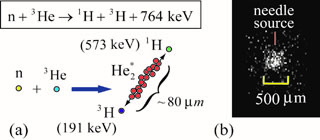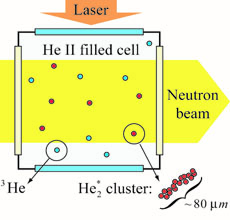He2* cluster tracking velocimetry technique
Another technique that we are developing is based on tracking small He2* clusters created in He II via neutron-3He absorption reactions. A compelling reason for developing this technique is that it will produce full-space velocity-field information that can hardly be obtained using the tracer-line tracking method. Knowing the full-space velocity field is essential in visualizing eddy structures and large-scale flow patterns that in some cases can control the flow properties [1]. In the past, many efforts were devoted in developing PTV methods for mapping the normal-fluid velocity field by tracking seeded micron-sized tracers [1-4]. However, these methods all have inherent issues since the tracer motion can be affected by both the normal fluid and the vortices. Our He2* cluster tracking technique will provide an ultimate solution to the long-lasting quest for unambiguous normal-fluid velocity field measurement.

Figure 1: (a) Schematic diagram showing the neutron-3He absorption reaction that leads to the creation of a cluster of about 104 He2* molecules. (b) A fluorescence image of a cloud of about 103 He2* molecules, produced by pulsing a needle source in He II [9]. We expect higher fluorescent light intensity from the clusters as they comprise more He2* molecules.
3He atoms that exist in He II as impurity particles can absorb neutrons (see the reaction schematic in Fig. 1 (a)) [5]. The absorption cross-section σ depends on the energy of the incident neutrons and can be quite large for thermal neutrons that have spins aligned with the 3He atoms (i.e. σ ~ 10-20 cm2) [6]. This reaction produces two charged particles, a proton (1H) and a tritium (3H), that move back to back with a total kinetic energy of 764 keV [7]. The two particles have sufficient energies to ionize and excite ground state 4He atoms along their tracks in He II , which leads to the generation of He2* molecules. The total length of the two tracks is about 80 μm, evaluated based on the known energy deposition rate of 1H and 3H in helium [7]. We also estimate that more than 104 molecules are produced, considering the fraction of the kinetic energy that goes to the generation of He2* molecules [8]. Therefore, every n-3He absorption event in He II creates a cluster of about 104 He2* molecules. Imaging these clusters should be feasible since we have already demonstrated high-quality fluorescence imaging of tiny clouds of He2* molecules in He II (see Fig. 1 (b)) [9]. Due to the small molecular diffusion (~ 10 μm during typical drift time), every cluster can be treated as a single tracer, and a spatial resolution of a few tens of microns is achievable. Tracking these clusters will allow us to map out the full velocity field.

Figure 2: Schematic of the experiment for producing and imaging He2* clusters.
In order to study the generation of He2* clusters in He II as well as to characterize their size and intensity distributions, we have established a collaboration with a group of researchers at Nagoya University (i.e. Prof. Shimizu, Prof. Tsuji, Prof. Wada, et al.) to conduct experiments using the J-PARC neutron facility in Japan [10]. Our plan is to pass a thermal neutron beam with a suitable flux (i.e. ~104/cm2 per pulse) through a He II filled cell (see Fig. 2). By adjusting the concentration of 3He impurity, we will be able to tune the number density of the resulted He2* clusters. For instance, even with a 3He concentration as low as 50 ppm (part per million), about 102 clusters will be produced per 1 cm3 volume of He II, sufficient for velocity-field mapping purpose. This work will also lead to a sensitive mechanism for neutron detection.
Reference:
[1] T. Zhang and S.W. Van Sciver, "Large-scale turbulent flow around a cylinder in counterflow superfluid He-4 (He(II))", Nat Phys 1 (1), 36-38 (2005).
[2] G.P. Bewley, D.P. Lathrop, and K.R. Sreenivasan, "Superfluid helium - Visualization of quantized vortices", Nature 441 (7093), 588-588 (2006).
[3] M.S. Paoletti, R.B. Fiorito, K.R. Sreenivasan, and D.P. Lathrop, "Visualization of Superfluid Helium Flow", J Phys Soc Jpn 77 (11) (2008).
[4] M. La Mantia, D. Duda, M. Rotter, and L. Skrbek, "Lagrangian accelerations of particles in superfluid turbulence", J Fluid Mech 717 (2013).
[5] M.E. Hayden, G. Archibald, P.D. Barnes, W.T. Buttler, D.J. Clark, M.D. Cooper, M. Espy, R. Golub, G.L. Greene, S.K. Lamoreaux, C. Lei, L.J. Marek, J.C. Peng, and S.I. Penttila, " Neutron-detected tomography of impurity-seeded superfluid helium", Phys Rev Lett 93 (10) (2004).
[6] L.D.P. King and L. Goldstein, "The Total Cross Section of the He-3 Nucleus for Slow Neutrons", Phys Rev 75 (9), 1366-1369 (1949).
[7] J.S. Meyer and T. Sloan, "Neutron interactions in liquid He-3(2)", J Low Temp Phys 108 (3-4), 345-354 (1997).
[8] W. Guo and D.N. McKinsey, "Concept for a dark matter detector using liquid helium-4", Phys Rev D 87 (11), 115011 (2013).
[9] W. Guo, J.D. Wright, S.B. Cahn, J.A. Nikkel, and D.N. McKinsey, "Metastable Helium Molecules as Tracers in Superfluid He-4", Phys Rev Lett 102 (23), 235301 (2009).
[10] J-PARC, (Japan Proton Accelerator Research Complex), website: https://j-parc.jp/index-e.html.